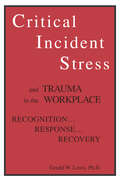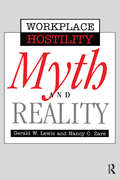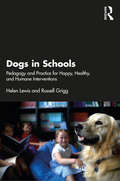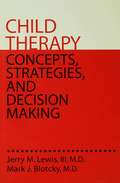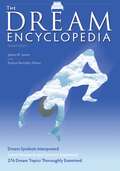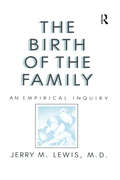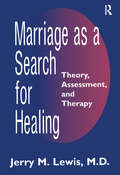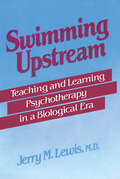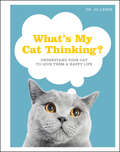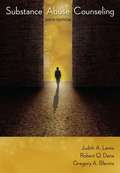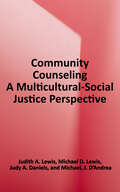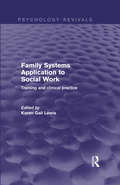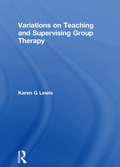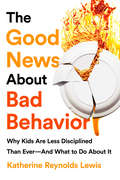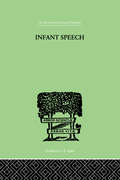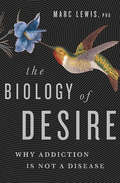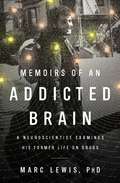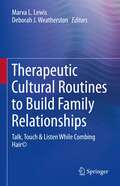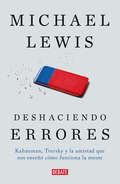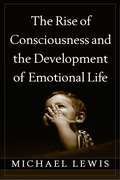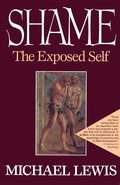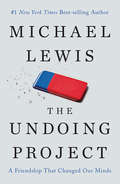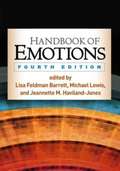- Table View
- List View
Critical Incident Stress And Trauma In The Workplace: Recognition... Response... Recovery
by Gerald W. LewisThis text was developed as a manual for those employed in the emergency services ESP, those who deal with victims of trauma in the workplace, work in school systems or acute psychiatric settings, provide assistance to ESP, or who are employed in other settings where persons may experience trauma. The book can also be used by mental health workers as they conduct workshops or provide debriefings where trauma has occured.Visit www.geraldlewis.com for more information.
Violence In The Workplace: Myth & Reality
by Gerald Lewis Nancy ZareVisit www.geraldlewis.com for more information.
Dogs in Schools: Pedagogy and Practice for Happy, Healthy, and Humane Interventions
by Helen Lewis Russell GriggUsing a wealth of infographics and classroom examples, Dogs in Schools sets out the pedagogical principles that schools can employ to work with school dogs in a way that promotes the well-being of all participants and creates a safe environment for all. This is the first book to combine theory and research with the views of experienced teachers and professionals working around the world, from the United Kingdom to India, from Australia to mainland Europe. Their perspectives illustrate the wide-ranging interest in school dogs but also highlight common concerns. For policymakers, this is a book not to ignore because it shows how dogs have the potential to make a significant contribution to children's well-being at a time of growing concern in this area. Simultaneously, the authors endorse the views of contributors who call for the introduction of humane regulations and fulsome guidance so that school dogs are viewed as sentient companions and not relegated to the latest educational fad. This is a must-read book for all those who are serious about humane education and ensuring the well-being and happiness of both children and dogs.
Dogs in Schools: Pedagogy and Practice for Happy, Healthy, and Humane Interventions
by Helen Lewis Russell GriggUsing a wealth of infographics and classroom examples, Dogs in Schools sets out the pedagogical principles that schools can employ to work with school dogs in a way that promotes the well-being of all participants and creates a safe environment for all.This is the first book to combine theory and research with the views of experienced teachers and professionals working around the world, from the United Kingdom to India, from Australia to mainland Europe. Their perspectives illustrate the wide-ranging interest in school dogs but also highlight common concerns. For policymakers, this is a book not to ignore because it shows how dogs have the potential to make a significant contribution to children's well-being at a time of growing concern in this area. Simultaneously, the authors endorse the views of contributors who call for the introduction of humane regulations and fulsome guidance so that school dogs are viewed as sentient companions and not relegated to the latest educational fad.This is a must-read book for all those who are serious about humane education and ensuring the well-being and happiness of both children and dogs.
Child Therapy: Concepts Strategies & Decision Making
by Jerry M. Lewis, III, MD Mark J. Blotcky, MDPublished in 1997, Child Therapy: Concepts, Strategies, And Decision Making is a valuable contribution to the field of Psychotherapy.
The Dream Encyclopedia
by James R Lewis Evelyn Dorothy OliverExploring the fascinating world of dreams, this comprehensive reference examines more than 250 dream-related topics, from art to history to science, including how factors such as self-healing, ESP, literature, religion, sex, cognition and memory, and medical conditions can all have an effect on dreams. Dream symbolism and interpretation is examined in historical, cultural, and psychological detail, while a dictionary-updated with 1,000 symbols and explanations-offers further insights. Dreaming about teeth, for instance, can indicate control issues, and dreaming of a zoo can indicate that the dreamer needs to tidy up some situation. Examining these concepts and more, this is the ultimate dreamer's companion.
The Birth Of The Family: An Empirical Enquiry
by Jerry M. LewisIn the Birth of the Family, Dr.Lewis continues one of the most important research projects in clinical psychiatry. It gives a picture of the interweaving of three relationships systems before, during and after the birth of the first child: the martial relationship of the parents, and the parental relationship with the new child. First published in 1990. Routledge is an imprint of Taylor & Francis, an informa company.
Marriage A Search For Healing
by Jerry M. LewisFirst published in 1997. Routledge is an imprint of Taylor & Francis, an informa company.
Swimming Upstream: Teaching and Learning Psychotherapy in a Biological Era
by Jerry M. LewisFirst published in 1991. The experiential base from which this book is written the author’s seminar for psychiatric residents which emphasizes that self-disclosure with colleagues is an important aspect of becoming a therapist. The ability to look at and listen to one's own work along with one's peers is important in the maturation process. In order to construct a context in which it is possible to learn from each other, I share many of my own psychotherapeutic experiences. More than this, however, Lewis shares personal experiences when they seem appropriate to the teaching-learning process.
What's My Cat Thinking?: Understand Your Cat to Give Them a Happy Life
by Jo LewisHave you ever wondered why your cats behave the way they do? This authoritative guide has all the answers! Cats are weird, and sometimes their behavior can leave you scratching your head. Discover what&’s really behind those things cats do – whether they&’re amusing, irritating or just downright bizarre.What&’s My Cat Thinking will help cat lovers unlock the secret code of cats for a deeper connection with the feline in your life. Inside, you&’ll find: • Accurate descriptions of behavior will help you understand your cat&’s body language nuances and act accordingly. • Covers a range of breeds. • A fun book for cat people that delivers practical, helpful advice from acknowledged experts on a range of tricky or puzzling cat behaviors. Have you ever wondered why your cat sleeps on your keyboard, why they bully the dog or why they insist on drinking from the bathroom tap — or if they even like you? Cats (unlike the dogs they look down on) are not always easy to understand. This cat psychology book will show you that they do show their feelings, albeit subtly, in the way they relate to you, other animals and their home environment. Stunning illustrations of a wide range of breeds and informative text will help you understand your cat's body language, so you know when they are happy and when they aren&’t! Aside from learning to understand your cat, this guide includes &“catwatching&” spreads that provide helpful tips and advice on dealing with some common kitty challenges like moving home and introducing a new cat into the family. So when they are sitting on your head at 4 a.m., you will at least know why!
Substance Abuse Counseling
by Judith A. Lewis Robert Q. Dana Gregory A. BlevinsSUBSTANCE ABUSE COUNSELING, 6th Edition, is at the cutting edge of the addiction field, combining a focus on the most current empirical studies with a firm belief that clients must be treated with a collaborative and respectful approach. These core values lay the basis for individualized treatment planning, attention to the client's social environment, a multicultural perspective and a recognition that client advocacy is part of the counselor's role. Effective and current best practices are discussed throughout the text, and learning objectives and key terms help students focus on areas of most importance.
Substance Abuse Counseling (Fourth Edition)
by Judith A. Lewis Robert Q. Dana Gregory A. BlevinsProviding an overview of substance abuse counseling, this volume emphasizes the need to treat clients from an individualized perspective, based on his or her particular behaviors, culture, gender, and mental health. Both the process of behavior change and the context in which it occurs are described in chapters on assessment and treatment planning, group work, working with families, preventing substance abuse, and the effects of drugs. Case studies illustrate the principles outlined and their practical applications. Appendixes include case history forms, initial behavior assessments, a comprehensive drinker profile, the Michigan Alcoholism Screening Test, a questionnaire on drinking and drug abuse, a family drinking survey, and lists of Web sites, treatment manuals, and self-help resources.
Community Counseling: A Multicultural-Social Justice Perspective
by Judith A. Lewis Michael D. Lewis Judy A. Daniels And Michael J. D’AndreaThis book clearly describes and illustrates the practice of community counseling by discussing the most current issues and practices for community work in the 21st century. <p><p>The Fourth Edition gives special emphasis to the practices of diversity, ethics, and the role of the counselor as a change agent and advocate. Focusing on how to promote change and growth, the text delivers effective guidelines for planning and implementing productive community counseling programs. It also provides readers with a basic understanding of the role of the community counselor, the services offered by community agencies, and the settings in which they are offered.
Family Systems Application to Social Work: Training and Clinical Practice (Psychology Revivals)
by Karen Gail LewisOriginally published in 1991, this title is a valuable social work text which demonstrated how to apply family system concepts to clinical situations encountered in work with inner-city populations at the time. Unlike traditional theories in clinical social work which were oriented toward the individual, this fascinating book offers a paradigm for social work that encompasses the client, his or her immediate and extended family, the community, the government, and the social worker. The family systems concepts in this refreshing volume are illustrated by case examples addressing the specific issues of AIDS and drug abuse, homelessness, foster care, wife abuse, care of those with intellectual disabilities, and adoption issues. Social workers and social work students can still gain perspective from these insightful chapters and will discover that it is not pathological people that make difficult populations, but difficult life situations that breed pathology.
Variations on Teaching and Supervising Group Therapy
by Karen Gail LewisLearn effective techniques for teaching and supervising group therapy. This unique new volume brings together teaching and supervisory models for a host of theoretical orientations, including psychodynamic, family systems, psychodrama, gestalt, and transactional analysis. Variations on Teaching and Supervising Group Therapy is essential reading for mental health professionals who currently conduct groups but who lack the specialized training for becoming a supervisor who currently teach group therapy from one theoretical orientation and want to learn about other modalities who teach academic courses on group therapy and want to expose students to a broader perspective of group modalities than the usual one or two models--psychoanalytic and activity groups--usually taught in schoolsThe contributing authors are social workers and professionals from other disciplines who represent a cross section of the teachers of the various types of groups being conducted in the United States today. They describe an exciting array of teaching formats--one-day workshops, semester-long courses, year-long training programs, weekly supervision sessions, and outside consultation--and settings, including family service agencies, child guidance centers, short-term health maintenance organizations, freestanding group training institutions, and private practice.Some of the highlights of this practical book include an examination of the most commonly used format in group therapy today--psychodynamics a demonstration of using family systems theory to understand the group therapy participants and process the key concepts and history of psychodrama the key concepts and basic aspects of a gestalt training program for practicing therapists strategies for teaching social work students a look at the skills needed for conducting group therapy with children a model for training therapists who conduct short-term groups
The Good News About Bad Behavior: Why Kids Are Less Disciplined Than EverAnd What to Do About It
by Katherine Reynolds LewisThe current model of parental discipline is as outdated as a rotary phone.Why don't our kids do what we want them to do? Parents often take the blame for misbehavior, but this obscures a broader trend: in our modern, highly connected age, children have less self-control than ever. About half of the current generation of children will develop a mood or behavioral disorder or a substance addiction by age eighteen. Contemporary kids need to learn independence and responsibility, yet our old ideas of punishments and rewards are preventing this from happening.To stem this growing crisis of self-regulation, journalist and parenting expert Katherine Reynolds Lewis articulates what she calls The Apprenticeship Model, a new theory of discipline that centers on learning the art of self-control. Blending new scientific research and powerful individual stories of change, Lewis shows that, if we trust our children to face consequences, they will learn to adapt and moderate their own behavior. She watches as chaotic homes become peaceful, bewildered teachers see progress, and her own family grows and evolves in light of these new ideas. You'll recognize your own family in Lewis's sensitive, realistic stories, and you'll find a path to making everyone in your home more capable, kinder, and happier--including yourself.
Infant Speech: A STUDY OF THE BEGINNINGS OF LANGUAGE (International Library Of Psychology Ser. #Vol. 77)
by Lewis, M M"First Published in 1999, Routledge is an imprint of Taylor & Francis, an informa company."
The Biology of Desire: Why Addiction Is Not a Disease
by Marc LewisThe psychiatric establishment in the Western world has unanimously branded addiction a brain disease. And the idea that an addict has an incurable illness, as opposed to a contemptible moral weakness, has served an historically important role in changing how addiction is understood, researched, and treated throughout the world. But as renowned developmental neuroscientist and recovered addict Marc Lewis argues in this illuminating, compelling, likely controversial book, addiction is not in fact a disease. Addiction, whether to drugs, alcohol, gambling, food, sex, or cigarettes, is rather a developmental learning process resulting from the normal functioning of the human brain. Through vividly rendered, compassionate stories of five addicts, interpreted in the light of state-of-the-art neuroscientific knowledge, Lewis shows how the compulsion to use arises in a brain that is highly efficient in pursuing singular goals. He reveals addiction as an unfortunate twist of fate for a brain doing what it’s designed to do--seek pleasure and relief--in a world that’s not cooperating. He shows that recovery from addiction is indeed possible,and that it is nothing like remission from a disease, because brain physiology doesn't need to change for addicts to get better. The Biology of Desire is vital and enlightening reading for anyone who has wrestled with addiction themselves, in their families, or as a medical or treatment professional. It illuminates a path to more effective treatment for addicts, and limns the essential requirements for individual recovery. Combining clearly rendered scientific explanation with insight, compassion, and even humor, Lewis boldly challenges us all to re-examine our approach to addiction, and whether the metaphors we've used to explain it have now become obstacles to healing.
Memoirs of an Addicted Brain: A Neuroscientist Examines his Former Life on Drugs
by Marc LewisMarc Lewis’s relationship with drugs began in a New England boarding school where, as a bullied and homesick fifteen-year-old, he made brief escapes from reality by way of cough medicine, alcohol, and marijuana. In Berkeley, California, in its hippie heyday, he found methamphetamine and LSD and heroin. He sniffed nitrous oxide in Malaysia and frequented Calcutta’s opium dens. Ultimately, though, his journey took him where it takes most addicts: into a life of addiction, desperation, deception, and crime. But unlike most addicts, Lewis recovered and became a developmental psychologist and researcher in neuroscience. In Memoirs of an Addicted Brain, he applies his professional expertise to a study of his former self, using the story of his own journey through addiction to tell the universal story of addictions of every kind. He explains the neurological effects of a variety of powerful drugs, and shows how they speak to the brain-itself designed to seek rewards and soothe pain-in its own language. And he illuminates how craving overtakes the nervous system, sculpting a synaptic network dedicated to one goal-more-at the expense of everything else.
Therapeutic Cultural Routines to Build Family Relationships: Talk, Touch & Listen While Combing Hair©
by Marva L. Lewis Deborah J. WeatherstonSocial workers and Infant and Early Childhood Mental Health (IECMH) helpers need practical, relationship-based clinical tools to support families experiencing stress, separation, and loss. Research reveals key parenting behaviors occur during hair combing interaction (HCI) – lively verbal interaction, sensitive touch, and responsiveness to infant cues. This book explores how the simple routine of combing hair serves as an emotionally powerful, trauma-informed, culturally valid therapeutic tool for use by mental health helpers. HCI offers a low-cost opportunity for IECMH helpers to engage families and sustain attachment relationships. In this book, case studies illustrate the use of HCI with diverse families of color. Each chapter includes questions for reflective supervision to understand sociocultural factors that may shape behaviors during HCI. Topics included in the text: The Observing Professional and the Parent’s Ethnobiography Introduction to Reflective Supervision: Through the Lens of Culture, Diversity, Equity, and Inclusion A Case Study in Cross-Racial Practice and Supervision: Reflections in Black and White Tools to Disrupt Legacies of Colorism: Perceptions, Emotions, and Stories of Childhood Racial Features Therapeutic Cultural Routines to Build Family Relationships: Talk, Touch & Listen While Combing Hair© is a unique resource for counselors, psychologists, psychiatrists, home visiting nurses, early childhood educators, and family therapists who work with military families or multiracial families with bi-racial children.“This book provides practical insights useful for professionals and parents. The authors share compelling experiences using strength-based and rich cultural approaches guided by reflective practice. It deserves to be widely read and become a classic resource.” Robert N. Emde, Emeritus Professor of Psychiatry, University of Colorado School of Medicine
Deshaciendo errores: Kahneman, Tversky y la amistad que nos enseñó cómo funciona la mente
by Michael LewisMichael Lewis examina en este brillante libro cómo la amistad entre David Kahneman y Amos Tversky revolucionó radicalmente nuestra manera de entender el funcionamiento de la mente humana. Hace más de cuarenta años, una serie de experimentos totalmente originales de dos jóvenes psicólogos, Daniel Kahneman y Amos Tversky, desmontaron todas las suposiciones existentes respecto al funcionamiento de la mente humana y la toma de decisiones. Deshaciendo errores es el maravilloso relato de la colaboración de estos dos hombres de ciencia que bien podrían ser grandes figuras literarias. Héroes académicos y bélicos -ambos tuvieron una importante carrera militar- sus investigaciones estuvieron profundamente ligadas a sus experiencias vitales. Tversky era un personaje brillante, con un magnetismo inusual, confiado y extrovertido; Kahneman, un fugitivo de la represión nazi durante su infancia, era un introvertido que se cuestionaba todo lo que le rodeaba. Su relación fue tan cercana, que resulta imposible saber de qué mente surgieron qué ideas: son de lejos el dúo más fascinante de la historia de la psicología conductiva. En su estilo habitual, Lewis nos ofrece un libro magistral sobre un tema pionero, explorado a través de las personalidades de dos asombrosos individuos tan fundamentalmente opuestos que sorprende que llegasen a ser amigos, tan siquiera colegas, pero que en el proceso cambiaron radicalmente la manera de entender cómo pensamos y por qué nos equivocamos tan fácilmente. Reseña:«Michael Lewis es el mejor contador de historia de nuestra generación.»Malcolm Gladwell
The Rise of Consciousness and the Development of Emotional Life
by Michael LewisSynthesizing decades of influential research and theory, Michael Lewis demonstrates the centrality of consciousness for emotional development. At first, infants' competencies constitute innate reactions to particular physical events in the child's world. These "action patterns" are not learned, but are readily influenced by temperament and social interactions. With the rise of consciousness, these early competencies become reflected feelings, giving rise to the self-conscious emotions of empathy, envy, and embarrassment, and, later, shame, guilt, and pride. Focusing on typically developing children, Lewis also explores problems of atypical emotional development.
Shame: The Exposed Self
by Michael LewisShame, the quintessential human emotion, received little attention during the years in which the central forces believed to be motivating us were identified as primitive instincts like sex and aggression. Now, redressing the balance, there is an explosion of interest in the self-conscious emotion. Much of our psychic lives involve the negotiation of shame, asserts Michael Lewis, internationally known developmental and clinical psychologist. Shame is normal, not pathological, though opposite reactions to shame underlie many conflicts among individuals and groups, and some styles of handling shame are clearly maladaptive. Illustrating his argument with examples from everyday life, Lewis draws on his own pathbreaking studies and the theory and research of many others to construct the first comprehensive and empirically based account of emotional development focused on shame. In this paperback edition, Michael Lewis adds a compelling new chapter on stigma in which he details the process in which stigmatization produces shame.
The Undoing Project: A Friendship That Changed Our Minds
by Michael Lewis<P>How a Nobel Prize-winning theory of the mind altered our perception of reality. <P>Forty years ago, Israeli psychologists Daniel Kahneman and Amos Tversky wrote a series of breathtakingly original studies undoing our assumptions about the decision-making process. Their papers showed the ways in which the human mind erred, systematically, when forced to make judgments in uncertain situations. Their work created the field of behavioral economics, revolutionized Big Data studies, advanced evidence-based medicine, led to a new approach to government regulation, and made much of Michael Lewis's own work possible. Kahneman and Tversky are more responsible than anybody for the powerful trend to mistrust human intuition and defer to algorithms. <P>The Undoing Project is about a compelling collaboration between two men who have the dimensions of great literary figures. They became heroes in the university and on the battlefield--both had important careers in the Israeli military--and their research was deeply linked to their extraordinary life experiences. Amos Tversky was a brilliant, self-confident warrior and extrovert, the center of rapt attention in any room; Kahneman, a fugitive from the Nazis in his childhood, was an introvert whose questing self-doubt was the seedbed of his ideas. They became one of the greatest partnerships in the history of science, working together so closely that they couldn't remember whose brain originated which ideas, or who should claim credit. They flipped a coin to decide the lead authorship on the first paper they wrote, and simply alternated thereafter. <P>This story about the workings of the human mind is explored through the personalities of two fascinating individuals so fundamentally different from each other that they seem unlikely friends or colleagues. In the process they may well have changed, for good, mankind's view of its own mind. <P><b>A New York Times Bestseller</b>
Handbook of Emotions, Fourth Edition
by Michael Lewis Lisa Feldman Barrett Jeannette M. Haviland-JonesRecognized as the definitive reference, this handbook brings together leading experts from multiple psychological subdisciplines to examine one of today's most dynamic areas of research. Coverage encompasses the biological and neuroscientific underpinnings of emotions, as well as developmental, social and personality, cognitive, and clinical perspectives. The volume probes how people understand, experience, express, and perceive affective phenomena and explores connections to behavior and health across the lifespan. Concluding chapters present cutting-edge work on a range of specific emotions. Illustrations include 10 color plates. New to This Edition *Chapters on the mechanisms, processes, and influences that contribute to emotions (such as genetics, the brain, neuroendocrine processes, language, the senses of taste and smell). *Chapters on emotion in adolescence, older age, and in neurodegenerative dementias. *Chapters on facial expressions and emotional body language. *Chapters on stress, health, gratitude, love, and empathy. *Many new authors and topics; extensively revised with the latest theoretical and methodological innovations.
